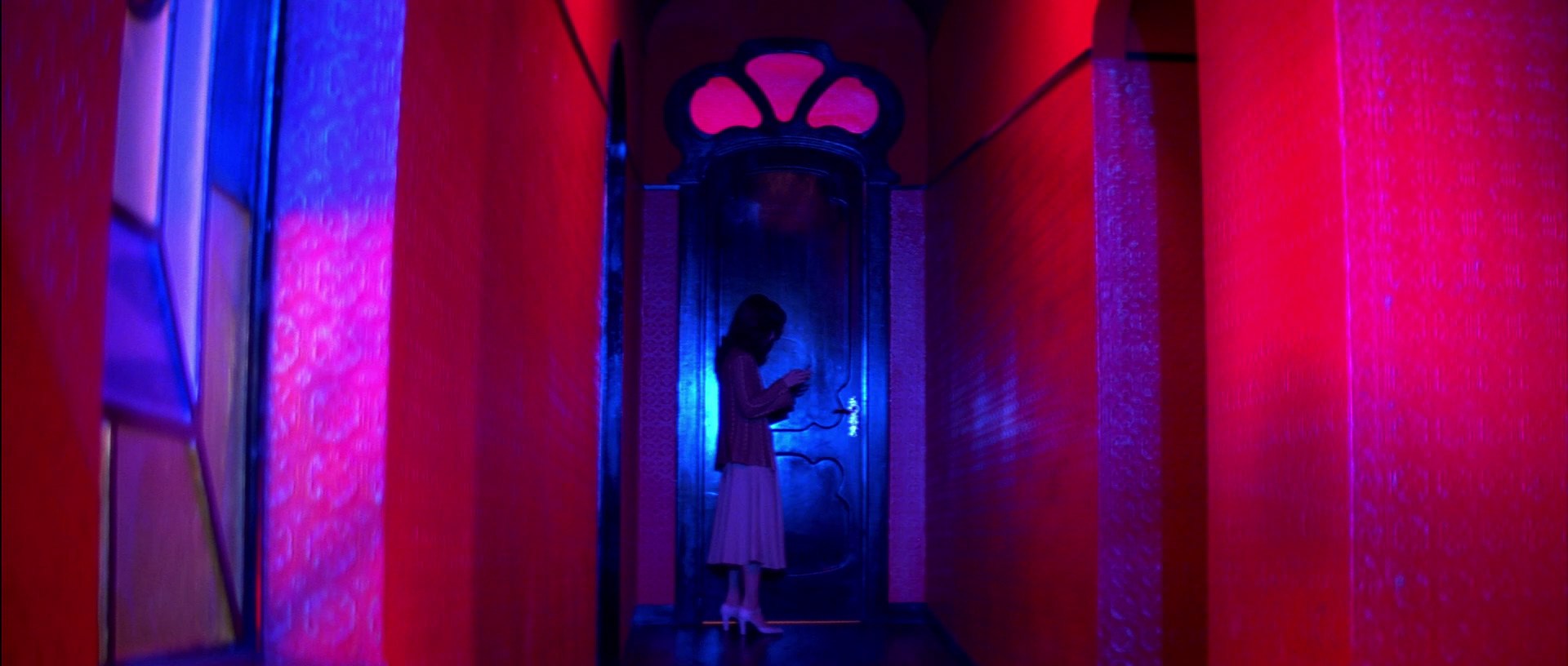
Suspiria is the 1977 cult classic Eurohorror film made by legendary director Dario Argento. In the film we follow Suzy Bannion (Jessica Harper) an aspiring ballerina who travels to Germany from the United States to attend the best ballet school in Europe. Her first night in town is marked with tragedy upon her arrival late one stormy night when she sees another student named Pat (Eva Axén) fleeing from the school while yelling confusing rantings. Pat is murdered later that night. Once Suzy settles in, more and more the school has an eerie feeling. Suzie often hears noises, feels ill, and some of the employees seem a little weird and out of place. As more people in and around the school die, Suzy slowly seeks to uncover just what makes the Tanz Dance Academy so mysterious.
Narratively, Suspiria is a straightforward horror film. As the audience journeys through Tanz alongside Suzy, the mystery behind just what is taking place at the ballet school pulls us in closer just as it does the character. Things are clearly not as they seem but figuring out who and what the pieces are, and where they fit exactly, is something that is going to unravel slowly. Watching this mystery unravel, learning just who to trust, and the history behind the school is engrossing and never boring, a story that compliments the horror aspect of the film perfectly. While the trademark Eurohorror over-the-top (for the time) gore for which Suspiria has become legendary is present, the film doesn’t rely on it solely; the question of just what the school’s headmasters are up to is an important and fleshed out part of the film and not just a means to the end of scaring the audience.
Part of what has made this film stand the test of time and become an enduring part of the mythos of cinema is its eye-popping visuals. Suspiria features monotoned color grading before the proliferation of digital cinematography, using dark blue and deep red hues to gorgeous and striking effect throughout. Argento’s use of vibrant colors from Suspiria’s opening moment span every part of its production design, from the lights emanating from buildings and inside of rooms to the look of the ballet school itself, both its facade and the interior design. Indeed, set design in Suspiria is what truly sets the film apart and makes it a visual marvel. The various set pieces such as European statues, the brilliant colored suede walls, the heavily patterned wallpaper, all make it so that your eyes remain transfixed on the screen taking in its picture as well as its story. The film’s look, combined with Argento’s frantic filming and use of light throughout, make Suspiria a total assault on the senses that viewers are unable to look away from. The entire look of the film has a flair that makes it one of the most interesting films to look at ever produced. Suspiria is one of the last films ever made in Technicolor, a vividly colored picture process that Argento utilized to accentuate the film’s nightmarish feel. The camera work from Argento and cinematographer Luciano Tovoli is also noteworthy, complete with fantastic tracking shots and various angles that serve to focus not just on the actors, but also center the set designs.
In addition to Suspiria’s classic visuals, the film’s soundtrack provided by 70s progressive rock band Goblin (with collaboration from Argento) is one that is sure to leave an impression on viewers. Its main title theme is a horror classic, with its twinkling keys and heavy bass whose sound almost sounds as if it’s sonically saying “doom!” The chants of “Witch!” in the song add to the sinister tone of the song and are what help to make it the enduring source of fear that it is. Music is expertly employed to set the mood from scene to scene, matching the terror and dread felt by characters onscreen.
More than forty years after its release, Suspiria remains at the vanguard of the horror genre both in terms of its look and its entertainment value. The plot has just enough heft to keep you engaged, the gore just bloody enough to add to the thrills but avoiding gratuitousness. Suspiria’s flaws that can be attributed to the times in which it was produced serve to actually add a bit to its charms. Whether it’s the mismatched vocal dubbing that was done entirely through ADR (additional dialogue recording, for film-making newbies) instead of being recorded during filming as was customary in 70s Italian cinema, or the fact that the blood in the film so clearly looks like paint. These oddities come across more as a look back at film-making ingenuity; using the limited technology and resources of the time to try to make audiences journey through imagination. As technology continues to progress quickly, making stories that once seemed impossible to film now common realities, it’s good to be reminded of the effort made by filmmakers of yesterday to craft something real out of the unreal just so that audiences could venture out into a world of entertaining fantasy for a couple of hours. Dario Argento’s masterwork is a gift to film-making and has left an indelible mark on the genre, its stylish appearance setting the standard for horror at the time and vaulting it into the annals of cinematic history.
Image: Synapse Films

